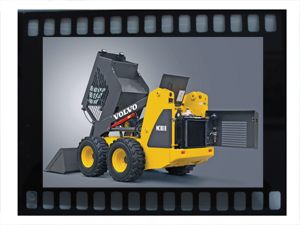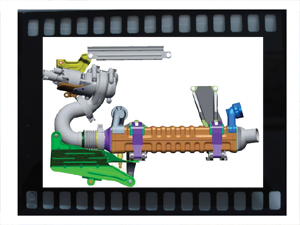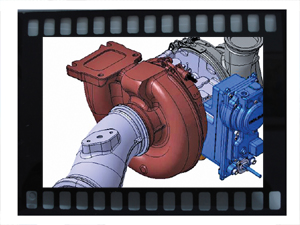A Sensible Introduction to Tier 4
What is Tier 4? How does it work? Why do we need it? When must manufacturers have Tier 4 engines in our construction equipment? How will Tier 4 affect the non-road equipment owner? This is a complex subject — one full of technology and engineering detail that may not easily be understood, but one must bear the burden of trying to comprehend.

Engines 25 to 75 hp
Tier 4 started in 2008 for engines less than 75 hp. In this power range Volvo has achieved 2008 Tier 4 emission levels without the need for exhaust aftertreatment. 2013 will see another significant reduction in emissions.
Engines 75 hp and greater
Tier 4 is composed of two significant stages. First is Tier 4a — sometimes referred to as Interim Tier 4 or Tier 4i and second is Tier 4b — sometimes referred to as Tier 4 final. The Tier 4 standards require significant emission reductions of both particulate matter (PM) and nitrogen oxides (NOx).
Tier 4a (Interim 4)
This includes a significant particulate matter or black smoke/soot reduction along with a significant NOx reduction. NOx is defined as nitrogen monoxide (NO) and nitrogen dioxide (NO2). Implementation year: 2011 for 175 to 750 hp (130 to 560 kW) and 2012 for 75 to 175 hp (56 to 130 kW).
Tier 4b
This is a further and substantial NOx-only reduction. Implementation year: 2014 for 75 to 750 hp (56 to 560 kW).
The Emission Box
In general, what is done within the engine to reduce NOx creates particulate matter. What is done to reduce particulate matter creates NOx. As high temperatures burn off the black soot or particulate matter, it creates NOx. Conversely, cooler temperatures reduce NOx but increase soot or particulate matter. This creates the problem of “getting in the box” that concerns engine developers.
Moving forward, we will see “in-cylinder” solutions and “external” solutions to emission reductions. In-cylinder solutions take care of emissions (either all or part) within the cylinder or combustion chamber. These solutions may have external help, like cooled exhaust gas recirculation (EGR), but ultimately what leaves the cylinder through the exhaust port meets the specific goal of the manufacturer.
If only part of the emission equation is solved in-cylinder, what is left must be treated externally. In the case of particulate matter treated externally, the use of a particulate filter may be used. NOx can be addressed through the use of a selective catalytic reduction (SCR) catalyst. There are arguments about which solutions provide the best efficiency, convenience and performance.

Crankcase Emissions
Emissions from the crankcase will now also be included in the total emission calculation. Crankcase emissions come from the hose that in the past has typically run from the top of the engine and been positioned to vent blow-by (combustion gases that slip by the pistons), containing oil mist directly into the atmosphere. This also allowed oil to drip directly on the ground. Crankcase breather systems are evolving to separate the oil and return it to the crankcase. The gases themselves are counted within the overall emission.
Emission Regulations Around the World
For customers and engine and machine manufacturers that operate on multiple continents, there will be new challenges. Tier 4a in North America is very similar to Stage III B in Europe and Tier 4b is similar to Stage IV. North America and Europe are “harmonized” — when the emission and implementation timeframes are the same or close enough. Japan will likely introduce regulations similar to and in the same timeframe as Europe and North America.
Tier 4 regulations require the use of ultra low sulfur diesel (ULSD) (15 ppm down from 500 ppm sulfur). This is the same fuel required by 2007 on-highway truck engines and becomes effective for non-road engines in June 2010. Lower levels of sulfur produce less particulate matter and sulfur dioxide. Generally, ULSD is also required to allow the use of catalysts in some emission control systems. Emission and fuel regulations are not the same and can vary greatly around the world. As we move into Tier 4a in North America, we will be forced to have different solutions in different parts of the world due to fuel availability.
Particulate Filter and Regeneration
A particulate filter is used to collect the particulate matter generated by combustion. Often called a particulate trap, it does just that — traps the particulate matter. As more and more material is collected, back pressure increases and the filter must be cleaned. The filter cleans itself by oxidizing the material in a process called regeneration. A separate muffler is typically not needed, as the particulate filter adequately silences the exhaust.
Cleaning of the particulate filter is accomplished by regeneration. Regeneration of the filter cleans it of particulate matter by converting it to nitrogen monoxide (NO) and water. The temperature within the filter must be at a certain level to make this happen. Regeneration can happen passively, actively or in a combination of both. Passive regeneration is accomplished through the use of a catalyst and requires a minimum exhaust temperature to make the reaction happen. Active regeneration is accomplished by adding heat through the use of a burner in the exhaust. A small amount of fuel can also be injected across a catalyst, raising the temperature and oxidizing the particulate matter. All this happens while the engine is running and results in no loss of production.
Just like the on-road particulate trap, ash is generated through the burning of small amounts of engine oil. Ash cannot be oxidized and therefore it collects and the trap will have to be cleaned at regular intervals. The use of low ash oils and advancements in engine oil control technology help to greatly reduce the need for ash cleaning.
Cooled Exhaust Gas Recirculation (EGR)

Air Handling and Turbocharging
Turbocharging is part of the emission design equation and results in the capability to deliver the optimum pressure in the intake and exhaust manifolds. This makes it possible to tailor the EGR flow back to the inlet manifold and also have optimum performance and fuel economy. Wastegated and variable geometry turbo (VGT) options allow specific tuning based on performance requirements. V-ACT continues to evolve, enhancing fuel injection and air handling, along with a new generation of engine management systems with greater speed and precision.
Selective Catalytic Reduction (SCR)
To get the significant reduction in NOx for Tier 4b in North America, we will see some different approaches in the market. One of the solutions to NOx reduction is SCR. SCR technology utilizes an additive called diesel emissions fluid (DEF) which is a non-toxic liquid (urea) currently produced and used in agriculture, food and cosmetics. DEF is injected into a catalytic converter, which converts the NOx to harmless nitrogen. If SCR technology is chosen, distribution of the additive will already be well-established in the on-highway market due to the majority of engine manufacturers introducing it in 2010.
Construction equipment requires specific engine performance characteristics. Volvo Construction Equipment has long recognized this, tailoring engine technology to optimize all aspects of machine operation and ownership. Other Volvo Group companies will ultimately choose the right technology from the vast array of tools in our toolbox to optimize engines to meet their customer needs and the demands to meet the ever-increasing environmental challenges.
John Bartz is an emission solutions manager for Volvo, based in Asheville, N.C.


Comments are closed here.